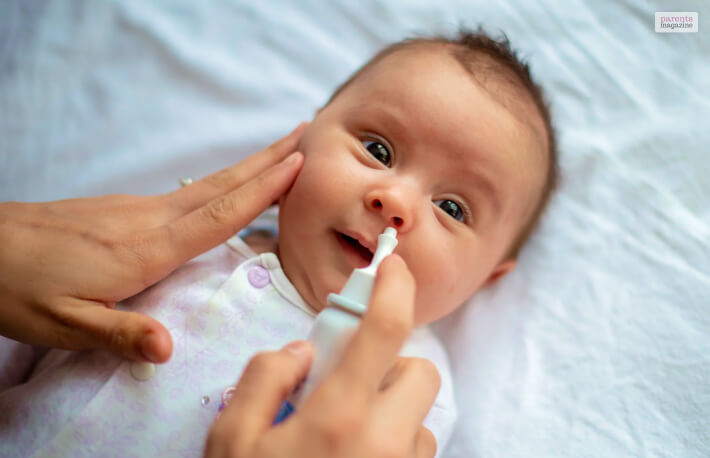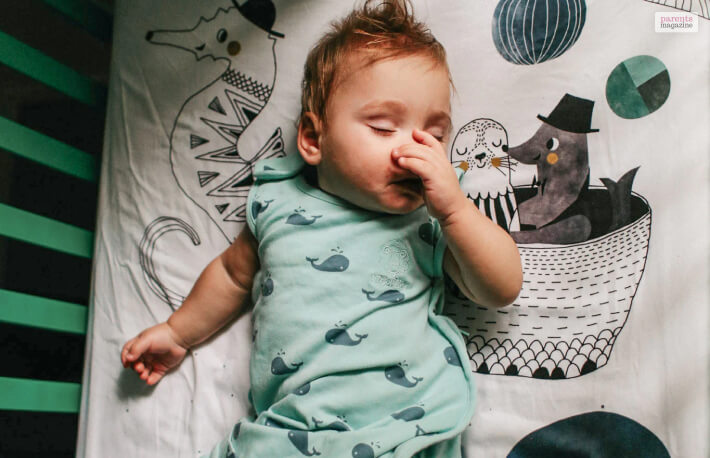
Sleep Soundly, Breathe Easily: Best Sleeping Position For Babies With Stuffy Noses And Congestion
It is difficult for a full-grown adult to sleep with a stuffy nose and congestion, so think about how a baby feels who has no idea what is happening to them and how they can get relief. They get fussy and whiny when they cannot sleep in general, and in this scenario, they are going through something that they have no idea about, which is causing them uneasiness and keeping them awake.
Babies generally sleep peacefully and comfortably when they get that comfort and warmth and feel safe in their mother’s arms. It is very important for their health to get enough sleep. Generally, babies sleep on the back and not on their bellies as that doesn’t allow them to get the necessary amount of oxygen and release an adequate amount of carbon dioxide.
So getting them to sleep in the correct position is also important. And it is something to be taken care of when they are suffering from a stuffy nose and congestion. Before getting to the best sleeping position for baby with stuffy nose, it’s better to know the issue in detail.
What Is The Reason Behind Congestion And Stuffy Nose?

Every human suffers from a stuffy nose and nose congestion, be it the adults or the little ones. And there are many reasons behind it. In babies, if they are suffering from a virus or cold their bosies produce some extra mucus to stop the bacteria or any other type of germs from getting into their bodies and do any more damage. It is something that happens very commonly in babies, it is their way of preventing invaders from gttinginto the body.
Dry air is also a cause behind nasal congestion. The body producing more mucous to keep the nasal passage lubricated. As their tiny bodies have tiny airways, a little bit of increase in mucous can feel like congestion.
Symptoms Which You See In A Baby With Stuffy Nose And Congestion:
- The first symptom that they show is sneezing.
- Runny nose along with thick mucous.
- They breathing becomes noisy.
- Coughing come along with sneezing and a runny nose.
- You will notice an increased fussiness.
- You will notice them sniffling even when they are sleeping.
- They lose appetite and refuse to sleep as well.
Best Sleeping Position For Baby With Stuffy Nose

When a baby is sleeping on their back it becomes more difficult for the body to remove the mucus and that leads to an uncomfortable buildup of mucus in their sinuses. The best sleeping position fr a baby in general is on their back but an exception for them is a colicky baby.
We often hear parents complaining that “my baby snores and sounds congested, what should i do?” or “what is the best sleeping position for my sick baby?” No need to worry, we are here to answer all your questions. Another major question is “is it ok to let baby sleep with stuffy nose?” Well, ofcourse not. But we are not doctors, so lets see what we can do with the sleeping position for a baby with congestion.
As we have discussed earlier that it is not okay to put a baby to sleep on their stomach or on their side, it might be good to consider to rearrange their cot to easy their discomfort a little bit. It would be easy for them to sleep in an upright or inclined position, as this helps the mucus to drip down easily through their mouth.
It could be good to put them in a bouncer or swing but keep an eye on them and don’t leave them unattended. Putting their head in a lifted position can help them. Use some pillows to keep their head and shoulder liftedas that can help with the congestion and drain them.
Putting them in a upright position will be really helpful as it will improve their breathing as well as help with their suffy nose. This will help them sleep and get them the rest they require. This is the best sleeping position for baby with stuffy nose.
It would also be helpful to carry your baby on your chest as they sleep. The reason behind doing all these drain the fluid from te ears instead of getting it build up or it can also cause an ear infection. So to conclude the best congested baby, sleep position, is upright.
What Other Measures Can You Take?
If you can guess the reason that is causing congestion in your baby, then you ca take the proper measures against it. If it is happening because of some kind of allergies, then it is best to keep the surroundings clean, or if it is happening from some kind of smoke then avoid burning scented candles or incense sticks.
But thereare some other techniques that you can use at home.
- Use a nasal aspirator or saline spray to clear they airways. It is absolutely okay to use saline solution for a baby. The process is to spray spritz into their nostrils to losen the mucous and clear the passageway. Using 1 to 2 saline drops is okay.
- Using nasal suction bulb is also a wayto clear mucus from their nostrils. Use a nasal bulb syringe could help them with this problem.
- As babies cannot blow their nose it is your job to get the excess mucus out of their nostrils. Use cotton swabs or tissues to clean it us so they can breathe freely.
- A warm bath is really helpful. It would relax them and get them rid of the fussiness.
- A congested nose can create nasal pressure, to ease some of the pressure massage their cheekbones, bridge of the nose and their temples.
- During the winters, the dryness of the atmosphere might make their congestion worse. It is preferable to use a cool-mist humidifier, which will keep their nasal track moist without heating up the nursery. Keep it out of their reach but close enough so that they get the air. Wash the humidifier every time you use it.
- Feeding a baby when they are sick is the biggest challenge ever. When they are congested and have a stuffy nose, they breathe through their nose and find it difficult to suck. However, it is important to keep a baby hydrated in this time so that they can fight germs and infections. So, to make up for the feeding time that has reduced, you can feed them often in small quantities to keep them hydrated.
- Keep their rooms clean; vacuum them regularly to keep away dust, pet dander, and smoke. Do not use scented fabric conditioners, avoid burning candles in their nursery. Avoid smoking in the house or car with them to keep them away from pollution.
When Should You Take Them To A Doctor?
It is generally nothing serious when your baby is congested and is dealing with a stuffy nose, but knowing the signs that might turn into something serious would help you take better care of your baby. You should take them to a doctor or seek immediate help if they show the following symptoms.
- Dehydration
- Difficulty in breathing.
- Wheezing
- If their lips are getting pale and turning bluish.
- If they have a cough for a long time and it is becoming painful.
- If they have a fever.
- If they are getting low on energy and are responding slowly.
- If they are not being able to keep liquids down.
- Dr. Jessica Daigle, MD NICU hospitalist, said, “If you know they have been exposed to someone with a viral infection, then it is still safe to call your doctor and let them or their nursing staff know what is going on so they are aware and can check on you and the baby even if they agree you do not need to come in immediately for assessment.”
- Try not to give them medicines on your own, and consult a doctor for guidance. It might happen that your baby is allergic to some medicines and might not respond well to something that another child does. Every child is different, so it is advised to avoid self-medication.
Wrapping up!
It is important to check for the symptoms because infants wont be able to speak out their problems. Ccheck for the symptoms, and take the necessary measures. Keep them in a upright position, hold them toyour chest and life tier head up while they are sleeping to ease their discomfort.
Have A Look :-
Already have an account?
Sign In
Create your account
User added successfully. Log in








